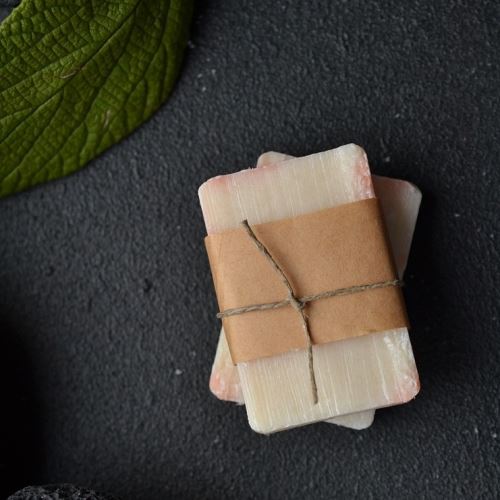If you are a beginner soap maker, before you start making this soap, I recommend trying a few simpler recipes first to gain experience. It is an exciting and joyful journey where you will enjoy the gradual improvement and always have a bar of soap to please someone with. It would be a shame to skip it, bring yourself grief with a failed attempt and spoil precious raw materials.
You can find beautiful recipes for the first soap here - Making the first soap with Zdenička.
Always pay attention to safety and hygiene during production. Sodium hydroxide, if handled improperly, can be very dangerous.
Soap with salt is a fantastic thing. It is wonderfully creamy and gently exfoliating. If you decide to do it, you will definitely not regret it. It is very hard and lasts longer in the shower than regular soap, which is a nice benefit. However, it needs to be left to mature like all proper soaps. I recommend at least 4, ideally 8 weeks.
I used Himalayan salt, but you can also use sea salt, just make sure it is "pure", meaning without additives (for example, iodine). Be sure to avoid salts with other minerals such as Epsom or Dead Sea salt. The soap will be very soft with this kind of salt.
In my recipe, there is 26% salt by weight of oils, but you can add more. If you want, feel free to add 100% salt from the weight of the oils. I recommend using finely ground salt to make the soap pleasant.
Since salt reduces the lather of the soap, a high content of coconut oil is used, which, on the contrary, increases the lather. In order for the soap not to dry the skin due to the high content of coconut oil, the "superfat ", i.e. unsaponified oil content, must be increased. In my recipe, "superfat " is 20.

I deliberately do not give the recipe (oils, water, sodium hydroxide) in grams, but as a guide so that you can adjust it according to the size of your mold. But definitely always use one of the soap calculators.

I recommend dosing the additives according to the manufacturer's recommendations.
Use the colors as you like, but I recommend "pre-mixing" them to avoid the need to mix the colors with an immersion blender, which unnecessarily speeds up the track and gives you less time to make.
I mixed Indigo and Madder root in warm distilled water, which I took from weighed water, Activated carbon in oil, which I took from weighed oils (olive). I mixed them well so that there were no lumps. There was no need to pre-prepare the sea buckthorn oil, I just dripped it directly from the bottle.
As for essential (or fragrant) oils, it is necessary to carefully observe the maximum permitted doses. If you are going to combine essential oils, I recommend using one of the calculators available online. I used a mixture of essential oils that I calculated at https://www.eocalc.com/.
What does it take?
Oils
- Coconut 75
- Extra virgin olive 10
- Shea butter 10
- Castor oil 5
Super fat 20
Water by weight of oil 30
Water: Lye ratio 2.20:1
Please always use the "soap calculator" for the calculation. I use http://soapcalc.net/
Additives
- Himalayan salt 26 from the weight of oils
- Raw silk
- Colloidal oatmeal (oat silk)
- Essential oils : Mint, Eucalyptus, Litsea Cubeba, Rosemary and Cedarwood (Atlas)
I use https://www.eocalc.com/ to recalculate EO
- Colors : Indigo, Madder root, Sea buckthorn oil, Activated carbon
Method: Cold process
How to do it?
Check out the video HERE or click the image below!
A few notes on the production itself
This soap hardens very quickly. First, because there is a high percentage of coconut oil and also because there is salt. It is therefore better to make it in individual molds so that it does not have to be cut. In this case, you don't have to be alert and you can only remove the soap from the molds the next day. If, after all, you decide to make it in a large form, you literally have to cut when it hardens. This can be a few hours depending on the temperature. It must be cut as soon as possible (it will still be warm), otherwise it will be very difficult to cut and it will start to crumble (fall apart).
Add salt only at the last moment and mix it well so that it does not remain at the bottom. After adding salt, the mixture will start to thicken very quickly, you have to take this into account. I do not recommend a complicated color design with this soap.
If you are using Tussah silk, I recommend that you first cut it finely and add it to the water immediately after the sodium hydroxide dissolves, while it is still hot and stir very well, let it dissolve.
If you have any questions, I will be happy to answer them. And I will look forward to your salty soaps.
Enjoy making! :)













































